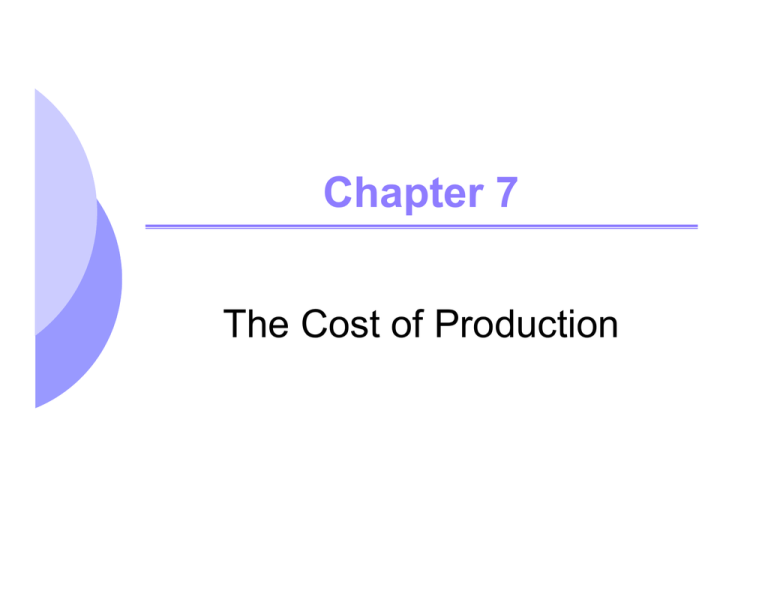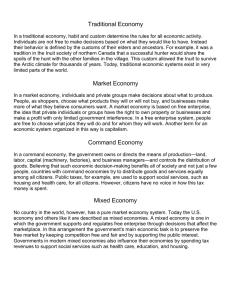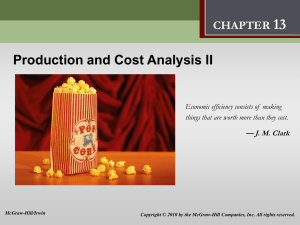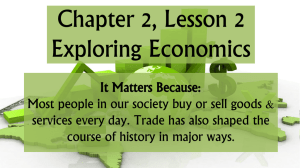Chapter 7 The Cost of Production
advertisement

Chapter 7 The Cost of Production Topics to be Discussed z Measuring Cost: Which Costs Matter? z Cost in the Short Run z Cost in the Long Run z Long-Run Versus Short-Run Cost Curves z Production with Two Outputs: Economies of Scope 2 Measuring Cost: Which Costs Matter? z Accountants tend to take a retrospective view of firms’ costs, whereas economists tend to take a forward-looking view z Accounting Cost Actual expenses plus depreciation charges for capital equipment z Economic Cost Cost to a firm of utilizing economic resources in production, including opportunity cost 3 Measuring Cost: Which Costs Matter? z Economic costs distinguish between costs the firm can control and those it cannot Concept of opportunity cost plays an important role z Opportunity cost Cost associated with opportunities that are foregone when a firm’s resources are not put to their highest-value use 4 Measuring Cost: Which Costs Matter? z Although opportunity costs are hidden and should be taken into account, sunk costs should not z Sunk Cost Expenditure that has been made and cannot be recovered Should not influence a firm’s future economic decisions 5 Sunk Cost z Firm buys a piece of equipment that cannot be converted to another use z Expenditure on the equipment is a sunk cost Has no alternative use so cost cannot be recovered – opportunity cost is zero Decision to buy the equipment might have been good or bad, but now does not matter 6 Measuring Cost: Which Costs Matter? z Total cost can be divided into: 1. Fixed Cost Does not vary with the level of output 2. Variable Cost Cost that varies as output varies TC = FC + VC 7 Fixed and Variable Costs z Which costs are variable and which are fixed depends on the time horizon z Short time horizon – most costs are fixed z Long time horizon – many costs become variable z Fixed cost and sunk cost are often confused 8 Measuring Costs z Marginal Cost (MC): The cost of expanding output by one unit Fixed costs have no impact on marginal cost, so it can be written as: ΔVC ΔTC MC = = Δq Δq 9 Measuring Costs z Average Total Cost (ATC) Cost per unit of output Also equals average fixed cost (AFC) plus average variable cost (AVC) TC TFC TVC ATC = = + q q q TC ATC = = AFC + AVC q 10 A Firm’s Short Run Costs 11 Determinants of Short Run Costs z Assume the wage rate (w) is fixed relative to the number of workers hired z Variable costs is the per unit cost of extra labor times the amount of extra labor: wL ΔVC wΔL MC = = Δq Δq 12 Determinants of Short Run Costs – An Example z Remembering that Δq MPL = ΔL ΔVC wΔL w MC = = = Δq Δq MPL 13 Production in the Short Run q q/L 112 TP C 30 AP 10 MP 0 1 2 3 4 5 6 7 8 9 10 Labor 0 1 2 3 4 5 6 7 8 9 10 Labor Cost Curves 120 Cost ($/unit) 100 MC 80 60 ATC 40 AVC 20 AFC 0 0 2 4 6 8 10 12 Output (units/yr) 15 Cost Curves z When MC is below AVC, AVC is falling z When MC is above AVC, AVC is rising z When MC is below ATC, ATC is falling z When MC is above ATC, ATC is rising z Therefore, MC crosses AVC and ATC at the minimums The Average – Marginal relationship 16 Cost Curves for a Firm z The line drawn from the origin to the variable cost curve: TC P 400 VC Its slope equals AVC The slope of a point 300 on VC or TC equals MC 200 Therefore, MC = AVC at 7 units of output 100 (point A) A FC 1 2 3 4 5 6 7 8 9 10 11 12 13 Output 17 Cost in the Long Run z Delta needs to compare its revenues and costs on an annual basis z If the firm had not purchased the plane, it would have earned interest on the $150 million z Forgone interest is an opportunity cost that must be considered Price of labor: wage rate (w) The price of capital (r) = depreciation rate + interest rate 18 Cost in the Long Run z The Isocost Line A line showing all combinations of L & K that can be purchased for the same cost Total cost of production is sum of firm’s labor cost, wL, and its capital cost, rK: C = wL + rK For each different level of cost, the equation shows another isocost line 19 Cost in the Long Run z Rewriting C as an equation for a straight line: K = C/r - (w/r)L Slope of the isocost: ΔK ΔL = − w r ( ) z -(w/r) is the ratio of the wage rate to rental cost of capital. z This shows the rate at which capital can be substituted for labor with no change in cost 20 Producing a Given Output at Minimum Cost Capital per year Q1 is an isoquant for output Q1. There are three isocost lines, of which 2 are possible choices in which to produce Q1. K2 Isocost C2 shows quantity Q1 can be produced with combination K2,L2 or K3,L3. However, both of these are higher cost combinations than K1,L1. A K1 Q1 K3 C0 L2 L1 C1 L3 C2 Labor per year 21 Input Substitution When an Input Price Change Capital per year If the price of labor rises, the isocost curve becomes steeper due to the change in the slope -(w/L). The new combination of K and L is used to produce Q1. Combination B is used in place of combination A. B K2 A K1 Q1 C2 L2 L1 C1 Labor per year 22 Cost Minimization in the Long Run (Profit Maximization in the LR) MRTS = - ΔK ΔL =− MPL Slope of isocost line = ΔK MPL MPK =w r OR MPK ΔL = −w r when firm minimizes cost MPL MPK = w r 23 A Firm’s Expansion Path Capital per year The expansion path illustrates the least-cost combinations of labor and capital that can be used to produce each level of output in the long-run. 150 $3000 Expansion Path 100 $2000 C 75 B 50 300 Units A 25 200 Units 50 100 150 200 300 Labor per year 24 Long Run Versus Short Run Cost Curves z In the short run, some costs are fixed z In the long run, firm can change anything including plant size Can produce at a lower average cost in long run than in short run Capital and labor are both flexible z We can show this by holding capital fixed in the short run and flexible in long run 25 The Inflexibility of Short Run Production Capital E per year Capital is fixed at K1. To produce q1, min cost at K1,L1. If increase output to Q2, min cost is K1 and L3 in short run. C Long-Run Expansion Path A K2 P Short-Run Expansion Path K1 In LR, can change capital and min costs falls to K2 and L2. Q2 Q1 L1 L2 B L3 D F Labor per year 26 Long Run Versus Short Run Cost Curves z Long-Run Average Cost (LAC) Most important determinant of the shape of the LR AC and MC curves is relationship between scale of the firm’s operation and inputs required to minimize cost 27 Long Run Versus Short Run Cost Curves 1. Constant Returns to Scale If input is doubled, output will double AC cost is constant at all levels of output 2. Increasing Returns to Scale If input is doubled, output will more than double LAC decreases at all levels of output 3. Decreasing Returns to Scale If input is doubled, output will less than double LAC increases at all levels of output 28 Long Run Versus Short Run Cost Curves z Long-run marginal cost leads long-run average cost: If LMC < LAC, LAC will fall If LMC > LAC, LAC will rise Therefore, LMC = LAC at the minimum of LAC z In special case where LAC is constant, LAC and LMC are equal 29 Long Run Average and Marginal Cost Cost ($ per unit of output LMC LAC A Output 30 Long Run Costs z Economies of scale reflects input proportions that change as the firm changes its level of production z Economies of Scale Increase in output is greater than the increase in inputs z Diseconomies of Scale Increase in output is less than the increase in inputs 31 Long Run Costs z Economies of scale are measured in terms of cost-output elasticity, EC z EC is the percentage change in the cost of production resulting from a 1-percent increase in output C C Δ EC = ΔQ Q = MC AC 32 Long Run Costs z EC is equal to 1, MC = AC Costs increase proportionately with output Neither economies nor diseconomies of scale z EC < 1 when MC < AC Economies of scale Both MC and AC are declining z EC > 1 when MC > AC Diseconomies of scale Both MC and AC are rising 33 Long Run Cost with Economies and Diseconomies of Scale 34 Production with Two Outputs – Economies of Scope z Many firms produce more than one product and those products are closely linked z Examples: Chicken farm--poultry and eggs Automobile company--cars and trucks University--teaching and research 35 Production with Two Outputs – Economies of Scope z 1. 2. 3. Advantages Both use capital and labor The firms share management resources Both use the same labor skills and types of machinery 36 Production with Two Outputs – Economies of Scope z The degree of economies of scope (SC) can be measured by percentage of cost saved producing two or more products jointly: C(q1 ) + C(q 2 ) − C(q1 ,q 2 ) SC = C(q1 ,q 2 ) C(q1) is the cost of producing q1 C(q2) is the cost of producing q2 C(q1,q2) is the joint cost of producing both products 37 Production with Two Outputs – Economies of Scope z With economies of scope, the joint cost is less than the sum of the individual costs z Interpretation: If SC > 0 Æ Economies of scope If SC < 0 Æ Diseconomies of scope The greater the value of SC, the greater the economies of scope 38 Production with Two Outputs – Economies of Scope z There is no direct relationship between economies of scope and economies of scale May experience economies of scope and diseconomies of scale May have economies of scale and not have economies of scope 39







